ORNO OR-CR-223 Handleiding
ORNO
Bewegingsdetector
OR-CR-223
Bekijk gratis de handleiding van ORNO OR-CR-223 (4 pagina’s), behorend tot de categorie Bewegingsdetector. Deze gids werd als nuttig beoordeeld door 58 mensen en kreeg gemiddeld 4.5 sterren uit 29.5 reviews. Heb je een vraag over ORNO OR-CR-223 of wil je andere gebruikers van dit product iets vragen? Stel een vraag
Pagina 1/4

OR- -2CR 23
(PL) Czujnik ruchu
(EN) PIR Motion sensor
(DE) Bewegungsmelder
ORNO-LOGISTIC Sp. z o.o.
ul. Rolników 437
44-141 Gliwice POLAND
tel. (+48) 32 43 43 110
WAŻNE!
Przed rozpoczęciem korzystania z urządzenia, należy zapoznać się z niniejszą instrukcją obsługi oraz zachować ją na przyszłość. Dokonanie samodzielnych napraw i modyfikacji skutkuje utratą
gwarancji. Producent nie odpowiada za uszkodzenia mogące wyniknąć z nieprawidłowego montażu czy eksploatacji urządzenia.
Z uwagi na fakt, że dane techniczne podlegają ciągłym modyfikacjom, Producent zastrzega sobie prawo do dokonywania zmian dotyczących charakterystyki wyrobu oraz wprowadzania innych
rozwiązań konstrukcyjnych niepogarszających parametrów i walorów użytkowych produktu.
Dodatkowe informacje oraz wsparcie techniczne związane z produktem dostępne na: www.support.orno.pl. Orno-Logistic Sp. z o.o. nie ponosi odpowiedzialności za skutki wynikające z
nieprzestrzegania zaleceń niniejszej instrukcji. Firma Orno-Logistic Sp. z o.o. zastrzega sobie prawo do wprowadzania zmian w instrukcji - aktualna wersja do pobrania ze strony www.support.orno.pl.
Wszelkie prawa do tłumaczenia/interpretowania oraz prawa autorskie niniejszej instrukcji są zastrzeżone.
1. Produkt przeznaczony do użytku wewnętrznego.
2. Instalacji powinien dokonywać elektryk lub osoba doświadczona.
3. Wszelkie czynności wykonuj przy odłączonym zasilaniu.
4. Nie zanurzaj urządzenia w wodzie i innych płyna ch.
5. Nie przykrywaj urządzenia podczas pracy.
6. Nie obsługuj urządzenia gdy uszkodzona jest obudowa.
7. Nie otwieraj urządzenia i nie dokonuj samodzielnych napraw.
8. Nie używaj urządzenia niezgodnie z jego przeznaczeniem.
9. Unikaj instalowania w pobliżu urządzeń grzewczych, klimatyzatorów itp.
IMPORTANT!
Before using the device, read this Service Manual and keep it for future use. Any repair or modification carried out by yourselves results in loss of guarantee. The manufacturer is not responsible for
any damage that can result from improper device installation or operation.
In view of the fact that the technical data are subject to continuous modifications, the manufacturer reserves a right to make changes to the product characteristics and to introduce different
constructional solutions without deterioration of the product parameters or functional quality.
Additional information and technical support related to the product is available at: www.support.orno.pl. Orno-Logistic Sp. z o.o. holds no responsibility for the results of non-compliance with the
provisions of the present Manual. Orno Logistic Sp. z o.o. reserves the right to make changes to the Manual - the latest version of the Manual can be downloaded from www.support.orno.pl. Any
translation/interpretation rights and copyright in relation to this Manual are reserved.
1. The product is designed for indoor use.
2. Installation should be carried out by an electrician or an experienced person.
3. Disconnect the power supply before any activities on the product.
4. Do not immerse the device in water or other fluids.
5. Do not cover the device during its operation.
6. Do not operate the device when its housing is damaged.
7. Do not open the device and do not repair it by yourselves.
8. Do not use the device contrary to its dedication.
9. Avoid installing near heating equipment, air conditioners, etc.
WICHTIG!
Bevor Sie das Gerät anschließen und benutzen, lesen Sie bitte diese Anleitung sorgfältig durch. Eigene Reparaturen und Modifikationen führen zum Verlust der Garantie. Der Hersteller haftet nicht
für Schäden, die durch unsachgemäße Montage oder Bedienung des Gerätes entstehen können.
Da technische Daten ständigen Modifikationen unterliegen, behält sich der Hersteller das Recht vor, Änderungen bezüglich Erzeugnischarakteristik und anderer Konstruktionsänderungen
vorzunehmen, die Parameter und Nutzwerte des Produkts nicht beeinträchtigen.
Weitere Informationen und technische Unterstützung zu diesem Produkt finden Sie unter: www.support.orno.pl. Orno-Logistic Sp. z o.o. haftet nicht für die Folgen der Nichtbeachtung der
Anweisungen in dieser Bedienungsanleitung. Orno-Logistic Sp. z o.o. behält sich das Recht vor, Änderungen in der Bedienungsanleitung vorzunehmen - aktuelle Version zum Herunterladen unter
www.support.orno.pl. Alle Rechte an Übersetzung/Dolmetschen und Urheberrechten an dieser Bedienungsanleitung sind vorbehalten.
1. Das Produkt ist für den Einsatz in Innenräumen.
2. Die Installation sollte von einer Elektrofachkraft oder einer erfahrenen Person durchgeführt werden.
3. Alle Arbeiten dürfen nur bei abgeschalteter Stromversorgung durchgeführt werden.
4. Tauchen Sie die Einrichtung niemals in Wasser oder anderen Flüssigkeiten.
5. Bei der Arbeit decken Sie die Einrichtung nie ab.
6. Bedienen Sie die Einrichtung nicht, wenn das Gehäuse beschädigt ist.
7. Öffnen Sie die Einrichtung nicht und führen Sie keine selbstständigen Reparaturen aus.
8. Verwenden Sie die Einrichtung nur ordnungsgemäß.
9. Vermeiden Sie die Installation in der Nähe von Heizgeräten, Klimaanlagen usw.
Każde gospodarstwo jest użytkownikiem sprzętu elektrycznego i elektronicznego, a co za tym idzie potencjalnym wytwórcą niebezpiecznego dla ludzi i środowiska odpadu, z tytułu obecności w sprzęcie niebezpiecznych
substancji, mieszanin oraz części składowych. Z drugiej strony zużyty sprzęt to cenny materiał, z którego możemy odzyskać surowce takie jak miedź, cyna, szkło, żelazo i inne. Symbol przekreślonego kosza na śmieci umieszczany
na sprzęcie, opakowaniu lub dokumentach do niego dołączonych oznacza, że produktu nie wolno wyrzucać łącznie z innymi odpadami. Oznakowanie oznacza jednocześnie, że sprzęt został wprowadzony do obrotu po dniu
13 sierpnia 2005 r. Obowiązkiem użytkownika jest przekazanie zużytego sprzętu do wyznaczonego punktu zbiórki w celu właściwego jego przetworzenia. Informacje o dostępnym systemie zbierania zużytego sprzętu
elektrycznego można znaleźć w punkcie informacyjnym sklepu oraz w urzędzie miasta/gminy. Odpowiednie postępowanie ze zużytym sprzętem zapobiega negatywnym konsekwencjom dla środowiska naturalnego i ludzkiego
zdrowia!
Each household is a user of electrical and electronic equipment, and hence a potential producer of hazardous waste for humans and the environment, due to the presence of hazardous substances, mixtures and components
in the equipment. On the other hand, used equipment is valuable material from which we can recover raw materials such as copper, tin, glass, iron and others. The weee sign placed on the equipment, packaging or documents
attached to it indicates the need for selective collection of waste electrical and electronic equipment. Products so marked, under penalty of fine, cannot be thrown into ordinary garbage along with other waste. The marking
means at the same time that the equipment was placed on the market after August 13, 2005. It is the responsibility of the user to hand the used equipment to a designated collection point for proper processing. Used
equipment can also be handed over to the seller, if one buys a new product in an amount not greater than the new purchased equipment of the same type. Information on the available collection system of waste electrical
equipment can be found in the information desk of the store and in the municipal office or district office. Proper handling of used equipment prevents negative consequences for the environment and human health!
Jeder Haushalt ist ein Anwender von Elektro- Elektronikgeräten und damit ein potenzieller Erzeuger von Abfällen, die für Mensch und Umwelt aufgrund des Vorhandenseins von gefährlichen Stoffen, Gemischen und und
Komponenten in den Geräten gefährlich sind. Andererseits sind Altgeräte ein wertvoller Rohstoff, aus dem Rohstoffe wie Kupfer, Zinn, Glas, Eisen und andere zurückgewonnen werden können. Das Symbol der durchgestrichenen
Mülltonne auf der Verpackung, dem Gerät oder den dazugehörigen Dokumenten, weist auf die Notwendigkeit der getrennten Sammlung von Elektro- und Elektronikaltgeräten hin. Auf diese Weise gekennzeichnete Produkte
dürfen unter Strafe nicht zusammen mit anderen Abfällen entsorgt werden. Die Kennzeichnung weist gleichzeitig darauf hin, dass die Geräte nach dem 13 August 2005 in Verkehr gebracht wurden. Es liegt in der Verantwortung
des Benutzers, die Altgeräte zur ordnungsgemäßen Behandlung an eine dafür vorgesehene Sammelstelle zu bringen. Informationen über das verfügbare System zur Sammlung von Elektroaltgeräten finden Sie in der
Informationsstelle des Ladens und im Magistrat/Gemeindeamt. Ein sachgemäßer Umgang mit Altgeräten verhindert negative Folgen für die Umwelt und die menschliche Gesundheit!
05/2021

2
SKRÓCONA INSTRUKCJA OBSŁUGI/ QUICK GUIDE/ KURZANLEITUNG
N - Zacisk neutralny/
Neutral terminal/
Neutrale Klemme
L - Napięcie
wejściowe/ Input
voltage/
Eingangsspannung
- Obciążenie/
Load/Belastung
rys.1/ fig.1/ Abb.1
rys.2/ fig.2/ Abb.2
rys.3/ fig.3/ Abb.3
rys.4/ fig.4/ Abb.4
rys.5/ fig.5/ Abb.5
rys.6/ fig.6/ Abb.6
rys.7/ fig.7/ Abb.7
SPECYFIKACJA TECHNICZNA/ TECHNICAL DATA/ TECHNISCHE DATEN
Zasilanie
Power supply
Stromversorgung
230V~, 50Hz
Max. obciążenie
Max. load
Max. Belastung
12 W 3 W00 00
Pobór prądu
Power consumption
Stromaufnahme
0,5W
Kąt detekcji czujnika
Detection angle
Erfassungswinkel
360°
Regulacja czujnika natężenia światła
Adjustable daylight sensor
Einstellbarer Tageslichtsensor
<3-2000 lux
Regulacja czasu świecenia
Adjustable time setting
Einstellbare Leuchtdauer
min. 10sek.±3sek.
max. min.±2min.15
Prędkość wykrywanego obiektu
Detected object's speed
Geschwindigkeit des erfaßten Objekts
0,6-1,5m/s
Regulacja zasięgu detekcji czujnika
Adjustable detection range
Einstellbarer Erfassungsbereich
Ø3-6m (<24°)
Stopień ochrony
Protection level
Schutzart
IP20
Waga netto
Net weight
Nettogewicht
0,11kg
Temperatura pracy
Working temperature
Betriebstemperatur
- °÷ °C20C 40
Wysokość montażu
Installation height
Montagehöhe
2,2-4m
Współpracuje z LED
Works with LED
Arbeitet mit LED
✓
Czujnik obecności
Presence sensor
Anwesenheitssensor
Przekaźnik
Relay
Relais
✓
PL
Instrukcja obsługi
CHARAKTERYSTYKA
Czujnik służy do automatycznego sterowania oświetleniem lub innymi urządzeniami elektrycznymi po wykryciu ruchu. Odbiornik (oświetlenie) jest włączane za pomocą czujnika ruchu PIR, który działa
na podczerwień. Pozwala on na włączenie oświetlenia pod wpływem ruchu obiektu wydzielającego ciepło w obrębie pola widzenia czujnika i pozostaje włączone tak długo jak długo czujnik ruchu
wykrywa ruch w obrębie pola widzenia. Jeśli w ustawionym czasie nie zostanie wykryty ruch oświetlenie lub inne podłączone urządzenie elektryczne zostanie automatycznie wyłączone.
OGÓLNE INFORMACJE
Wybierając miejsce montażu należy wziąć pod uwagę następujące kryteria:
- kąt zasięgu czujnika,
- czujnik nie powinien być kierowany na miejsce gdzie może być wykryty ruch zwierząt,
- czujnik nie powinien być kierowany na oświetlane jasne obiekty (tj. białe) lub będące źródłem ciepła, ponieważ mogą one wpływać negatywnie na pracę czujnika,
- nie montuj czujnika w pobliżu silnych źródeł zakłóceń elektromagnetycznych,

3
- upewnij się czy przewody zasilające posiadają odpowiednie zabezpieczenie prądowe w postaci właściwych bezpieczników lub inne urządzenia odłączające zasilanie w przypadku przeciążenia,
- zanieczyszczenie optyki czujnika powoduje, że zmniejsza się zasięg i czułość wykrywania ruchu,
- jeżeli różnica temperatur pomiędzy obiektem poruszającym się a otoczeniem jest niewielka (np. latem) czujnik może reagować później i zmniejszy się jego zasięg wykrywania ruchu.
INSTALACJA
1. Wyłącz zasilanie.
2. Sprawdź odpowiednim przyrządem stan beznapięciowy na przewodach zasilających.
3. Poluzuj śruby w kostce zaciskowej.
4. Podłącz przewody pod zaciski zgodnie ze schematem podłączenia.
5. Dokręć śruby kostki zaciskowej i załóż na miejsce przezroczystą pokrywę z plastiku.
6. Złóż metalowe sprężyny czujnika pionowo, aż będą leżały równolegle do jego korpusu, a następnie włóż czujnik do przygotowanego otworu w powierzchni montażowej lub skrzynce. Otwór musi
pasować wielkością do czujnika. Zwolnienie sprężyn zamocuje czujnik na miejscu.
7. Załącz obwód zasilania.
8. Dopasuj parametry pracy i przetestuj czujnik.
TEST
LUX - regulacja natężenia światła
Ustawienie to określa przy jakim natężeniu światła urządzenie przestaje wykrywać ruch, pozostając w trybie oczekiwania. Zabezpiecza to przed niepożądanym włączaniem oświetlenia podczas dnia.
Porę świecenia ustawia się pokrętłem “LUX”, które należy przekręcić do oporu zgodnie z ruchem wskazówek zegara i poczekać do zmierzchu. Gdy zacznie się ściemniać należy ustawić porę świecenia
przekręcając pokrętło “LUX” do momentu włączenia się światła.
TIME - regulacja czasu świecenia
Pokrętło umożliwia określenie czasu przez jaki urządzenie będzie działało po aktywacji czujnika. Czas świecenia liczy się od momentu wykrycia ruchu do momentu wyłączenia.
SENS - regulacja czułości czujnika
- Przekręć pokrętło SENS w kierunku zgodnym do ruchu wskazówek zegara na maksimum (+).
- Pokrętło TIME przekręć w kierunku przeciwnym do ruchu wskazówek zegara na minimum (10s).
- Pokrętło LUX przekręć w kierunku zgodnym do ruchu wskazówek zegara na maksimum
- Włącz zasilanie i odczekaj ok. 30 sekund aby czujnik ustawił się do otoczenia. Po tym czasie czujnik po wykryciu ruchu załączy podłączone oświetlenie.
- Jeśli czujnik nie wykryje ruchu wyłączy się w ciągu 10 ±3 sek. Obróć pokrętło „LUX” w kierunku przeciwnym do ruchu wskazówek zegara, tj. położenie minimalne. Jeżeli natężenie oświetlenia otoczenia
nie przekracza 3 luksów, światło sterowane przez czujnik nie powinno się włączyć. Jeżeli zakryjemy czujnik przedmiotem nieprzepuszczającym światła, czujnik powinien włączyć światło, a następnie
jeśli nie wykryje ruchu wyłączyć je w ciągu 10 ±3 sekund.
UWAGA: Podczas przeprowadzania testu czujnika w dzień pokrętło LUX należy ustawić na pozycje MAX w przeciwnym razie czujnik nie będzie działał prawidłowo. W przypadku urządzeń
o obciążeniu powyżej 60W odległość pomiędzy lampą a czujnikiem powinna wynosić co najmniej 60 cm.
NIEKTÓRE PROBLEMY I SPOSOBY ICH ROZWIĄZANIA
Obciążenie nie działa:
a. Sprawdź podłączenie zasilania i odbiornika.
b. Sprawdź odbiornik.
c. Sprawdź ustawienia czujnika i ustawienia natężenia oświetlenia otoczenia.
Słaba czułość:
a. Sprawdź, czy przed czujnikiem nie znajdują się urządzenia, które mogą zakłócić odbierane sygnały.
b. Sprawdź temperaturę otoczenia.
c. Sprawdź, czy wykrywany obiekt znajduje się w polu detekcji.
d. Sprawdź wysokość instalacji.
Czujnik nie może automatycznie wyłączyć obciążenia:
a. Sprawdź, czy w polu detekcji nie występują ciągłe sygnały ruchu.
b. Sprawdź, czy opóźnienie czasowe nie jest ustawione na najdłuższą wartość.
c. Sprawdź, czy zasilanie jest zgodne z instrukcją.
d. Sprawdź, czy czujnik nie jest zamontowany w pobliżu klimatyzatora lub centralnego ogrzewania, itp.
BEZPIECZEŃSTWO I KONSERWACJA
Konserwację wykonywać należy przy odłączonym zasilaniu. Czyścić wyłącznie delikatnymi i suchymi tkaninami.
Nie używać chemicznych środków czyszczących. Nie zakrywać wyrobu. Zapewnić swobodny dostęp powietrza.
EN
Operating and installation instructions
DESCRIPTION
The sensor is used to automatically control lighting or other electrical devices when motion is detected. The receiver (lighting) is switched on by means of a PIR motion sensor, which operates on infrared.
It allows the lighting to be switched on when an object that emits heat within the sensor's field of view moves and remains switched on as long as the motion detector detects movement within the
field of view. If no movement is detected within the set time, the lighting or other connected electrical equipment is automatically switched off.
GENERAL REMARKS
While choosing a place of installation, consider the following criteria:
- detection angle of the sensor,
- do not install in places where animal movement can be detected,
- the sensor should not be aimed at lit bright (i.e. white) objects or at heat sources as they can impair the sensor operation,
- do not install in the vicinity of strong sources of electromagnetic interference,
- make sure if the power leads have the suitable current protection such as proper fuses or other power disconnecting devices in case of overload,
- optical system pollution results in decrease of the range and the motion detection sensitivity.
- if the temperature difference between a moving object and its ambience is low (eg. in summer), the sensor can respond later and its motion detection range will be reduced.
INSTALLATION
1. Disconnect power source
2. Check with a suitable instrument that there is no voltage on the supply wires.
3. Loosen the screws on the terminal block.
4. Connect the wires to the terminals according to the wiring diagram.
5. Tighten the terminal block screws and put th plastic cover in place.e
6. Fold the metal springs of the sensor vertically until they lie parallel to the sensor body, then insert the sensor into the prepared hole in the mounting surface or box. The size of hole must fit to the
sensor. Releasing the springs will secure the sensor in place.
7. Switch on the power supply.
8. Adjust the parameters and test the sensor.
TEST
LUX - Adjustable daylight sensor
This setting specifies the luminous intensity at which the device stops motion detection while remaining in the stand-by mode. This secures against undesirable lighting switching on by day. The light
season is set with the "LUX" knob, which must be turned clockwise to the stop and waited until dusk. If the light starts to darken, set the light time by turning the "LUX" knob until the light turns on.
TIME - Adjustable time setting
The knob allows you to determine the time for which the device will operate when the sensor is activated. The light time is counted from the moment the motion is detected to the moment it is switched
off.
SENS - sensor sensitivity adjustment
- Turn the SENS knob clockwise to maximum (+).
- Turn the TIME knob anti-clockwise to the minimum (10s).
- Turn the LUX knob clockwise to maximum
- Turn on the power and wait about 30 seconds for the sensor to adjust to with the environment. After this time, the sensor will switch on the connected lights when motion is detected.
- If the sensor does not detect movement it will turn off within 10 ±3 sec. Turn the "LUX" knob anti-clockwise- the minimum position. If the ambient light intensity does not exceed 3 lux, the sensor
controlled light should not turn on. If you cover the sensor with an object that does not penetrate the light, the sensor should turn on the light and then, if it does not detect motion, turn off the light
within 10 ±3 seconds.
Note: when testing in daylight, please turn LUX knob to (MAX ) position, otherwise the sensor could not work properly! If the lamp is more than 60W, the distance between lamp and sensor
should be 60cm at least.
Product specificaties
| Merk: | ORNO |
| Categorie: | Bewegingsdetector |
| Model: | OR-CR-223 |
Heb je hulp nodig?
Als je hulp nodig hebt met ORNO OR-CR-223 stel dan hieronder een vraag en andere gebruikers zullen je antwoorden
Handleiding Bewegingsdetector ORNO
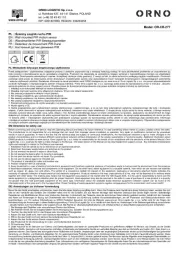
11 Juni 2025
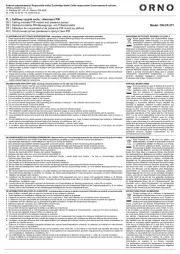
11 Juni 2025
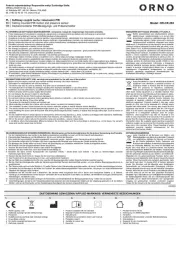
10 Juni 2025

10 Juni 2025
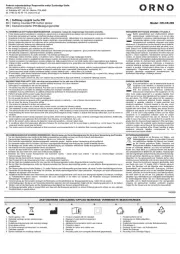
10 Juni 2025
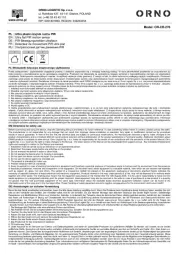
10 Juni 2025
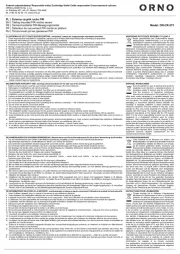
10 Juni 2025

9 September 2024

9 September 2024

9 September 2024
Handleiding Bewegingsdetector
- Axis
- Gewiss
- Aqua Joe
- Merten
- Inovonics
- Optex
- BEA
- EQ-3
- Vemer
- Marmitek
- Kopp
- Renkforce
- Philips
- Somfy
- Blaupunkt
Nieuwste handleidingen voor Bewegingsdetector
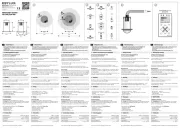
6 Juli 2025
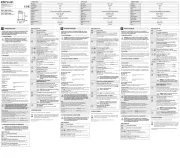
6 Juli 2025
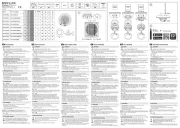
5 Juli 2025

5 Juli 2025
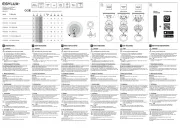
5 Juli 2025
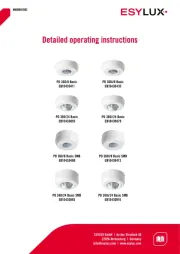
5 Juli 2025
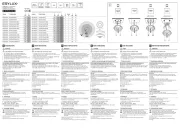
5 Juli 2025
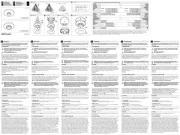
5 Juli 2025
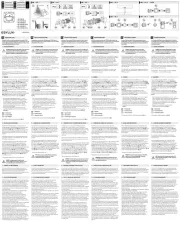
5 Juli 2025
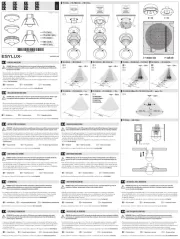
4 Juli 2025